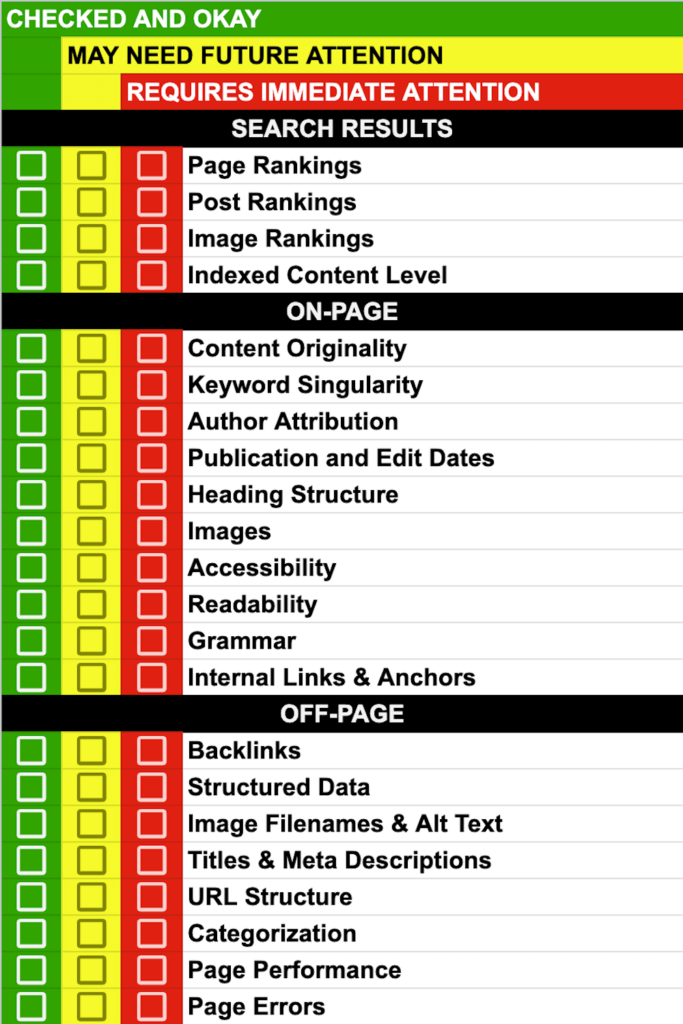Many business websites that are less than a few years old have negligible organic search traffic outside of some brand searches.
Why?
For one, the blog content they invested in appears very low in the search results.
Therefore, when people search for answers to problems the business’s product or service solves, they don’t see any of the company’s blog content unless they scroll down the search results page.
Some blog posts may not be in the Google index, meaning they will not appear anywhere in the search results.

This lack of visibility is usually due to a combination of factors.
Should action be taken?
Revenue leaders are sometimes unconcerned about not having organic search traffic, as other marketing channels generate as much interest as the sales team can handle.
In other cases, revenue leaders want to increase awareness of their product or service by improving organic search traffic.
For those in the latter camp, a multi-point SEO inspection (a.k.a. website audit) will identify areas that require attention. Below is a brief description of each point.
An inspection is followed by recommendations on addressing any items that require attention.
Inspection points
These are some of the items covered by a multi-point inspection.
Search results
Page Rankings: Measure how well a website’s pages (homepage, products, services) perform in search engine results.
Post Rankings: Evaluate the visibility and search engine ranking of blog posts, which reflects their ability to attract organic traffic.
Indexed Content Level: Identify pages and posts that search engines have not indexed. Non-indexed content cannot be found through search.
On-page
Content Originality: Assess whether a website’s content has original components and does not contain all restated ideas from other sources.
Content Helpfulness: Examine if the website’s content addresses the needs and questions of its audience and conforms to Google’s Helpful Content Guidelines.
Keyword Singularity: Determine whether the same or similar focus keywords are used in multiple blog posts, which can dilute their effectiveness in the search results.

Author Attribution: Evaluate the presence of author information for blog content, which can impact credibility and authority for a given topic.
Publication and Edit Dates: Make sure it’s clear to readers and search engines how fresh specific content is.
Accessibility: Assess how easily people with disabilities can access and navigate the website, affecting user experience and SEO.
Readability: Look at how the information is formatted on blog posts. Assess whether it’s easy for a reader to scan a post and quickly find what’s most relevant to them.
Grammar: Check the website’s content for grammatical errors, overused words, overly complex sentence structure, and excessive use of the passive voice.
Headings: Analyze the organization and hierarchy of headings and subheadings (H1, H2, H3) in pages and posts, which helps structure content for better user and search bot understanding.
Internal Links: Assess the website’s internal linking levels and how descriptive anchor texts are.
Off-page
Backlinks: Evaluate the quantity and quality of external sites linking to the website, which is a critical factor in search engine ranking algorithms.
Page performance: Check the load times for pages and blog posts. Poor performance can affect how content ranks.
Titles & Meta Descriptions: Ensure meta descriptions are used consistently and contain the right words. Check the length of titles.
URLs: Review the blog post URLs to ensure they have the proper structure and are concise.
Categorization: Check whether blog categories are being used and whether they’re being used properly.
Images: Evaluate image filenames, file sizes, formats, and alt text to ensure images are optimized for load speed and search visibility.
Addressing the results of a multi-point SEO inspection is a critical step in getting long-term value from a business blog.
Various inspection tools must be used to analyze and report the above points.
With the right tools, an experienced SEO can recommend what needs to be addressed so that your content ranks higher in the search results.


